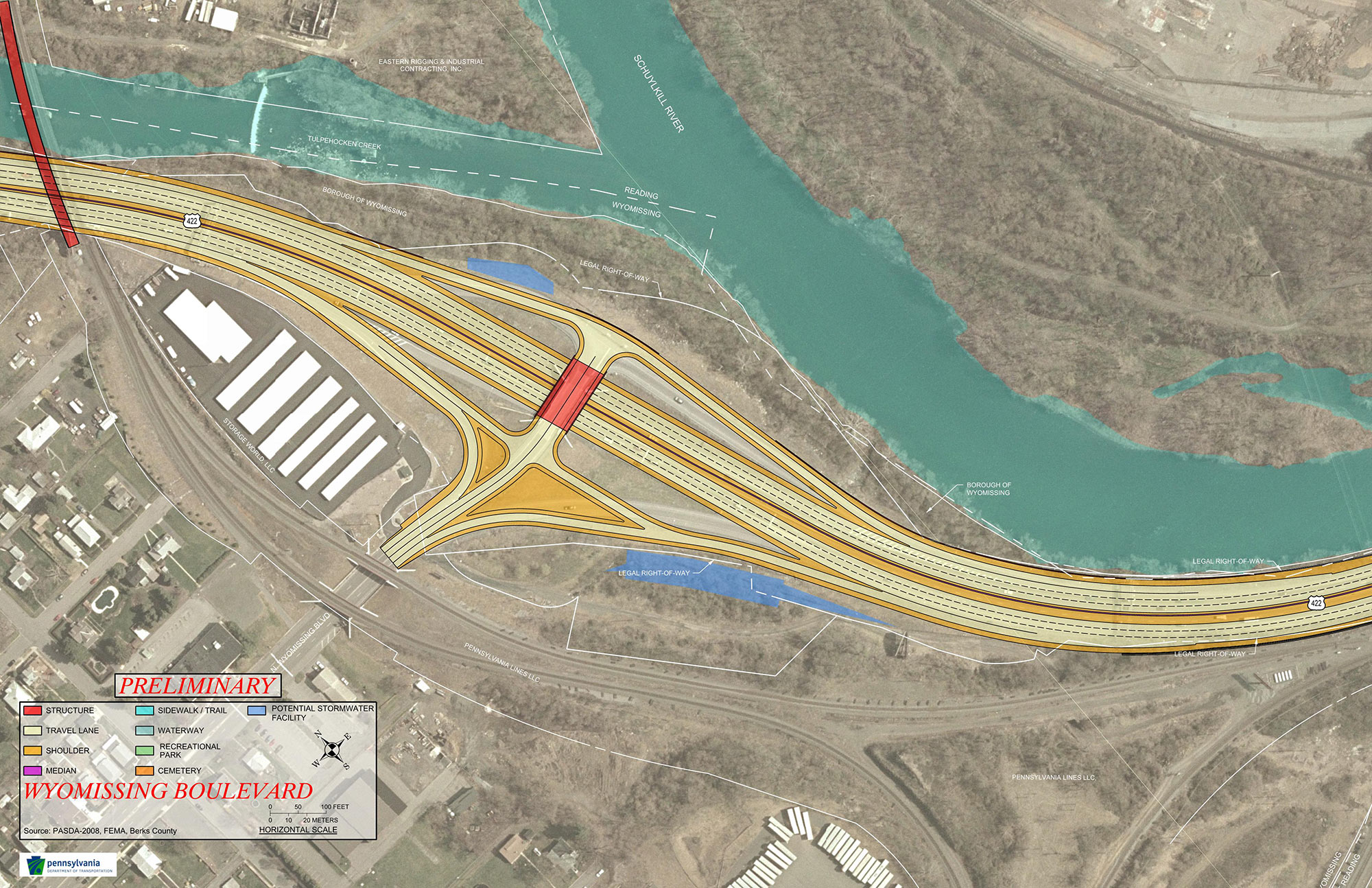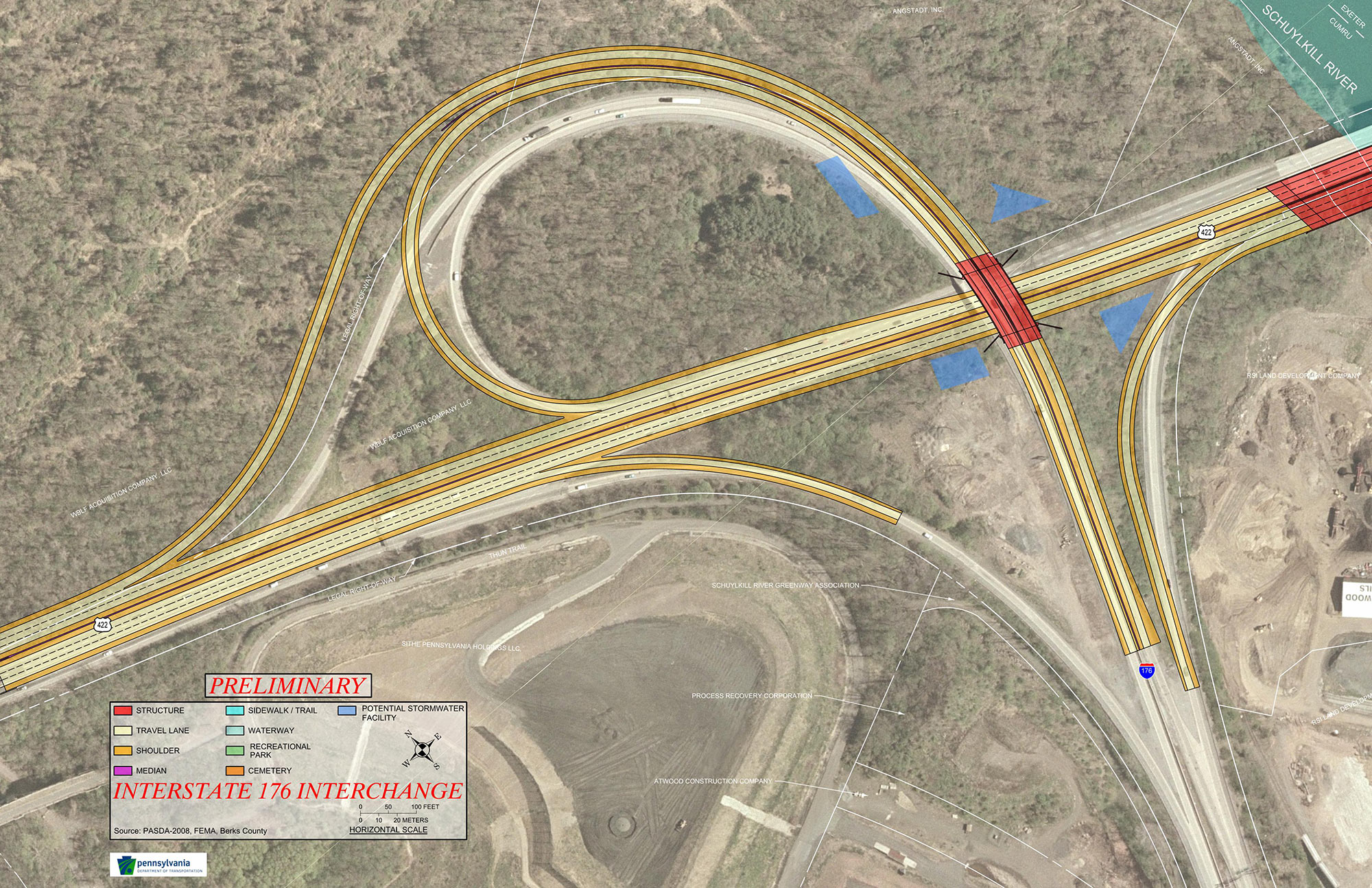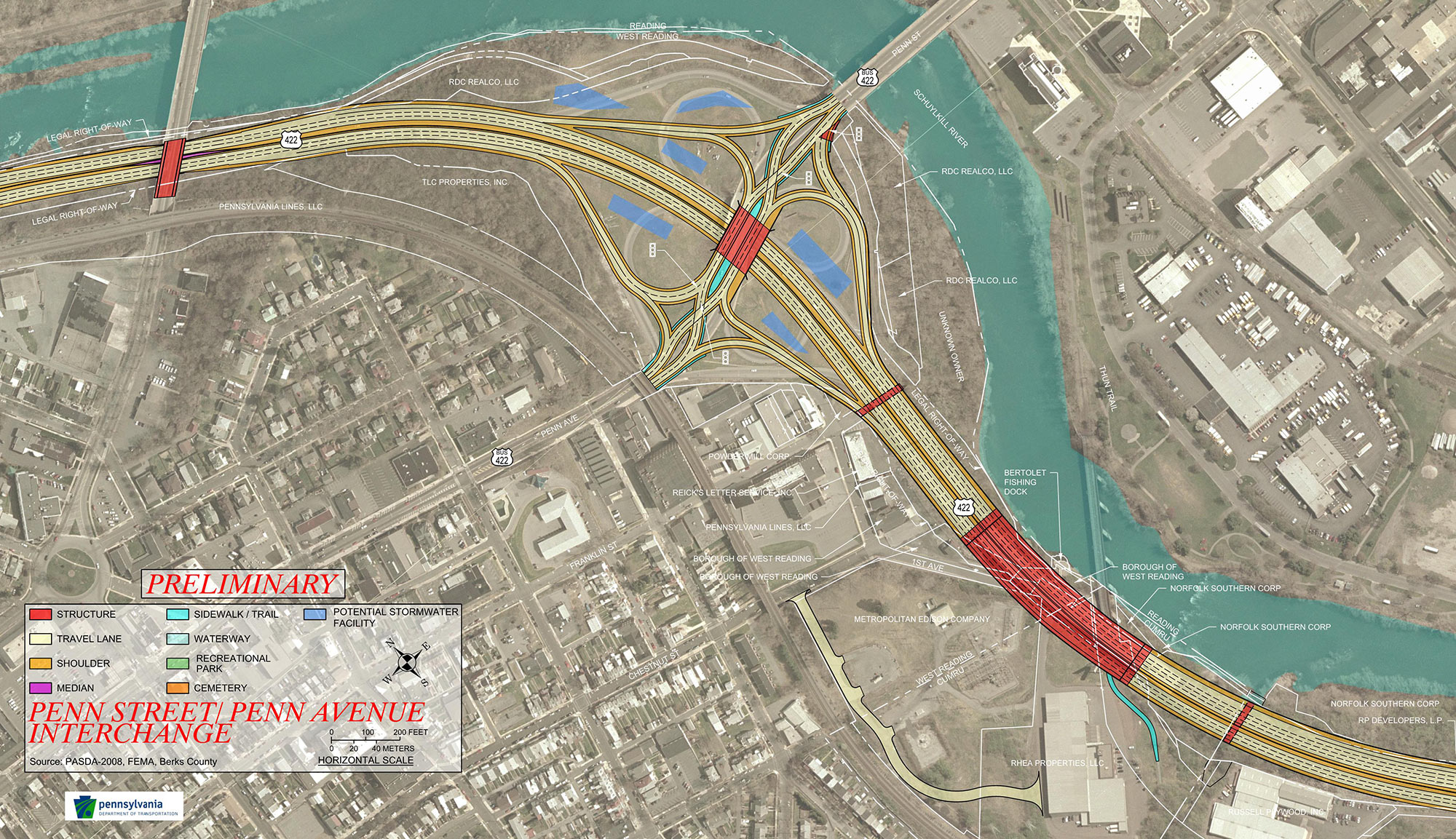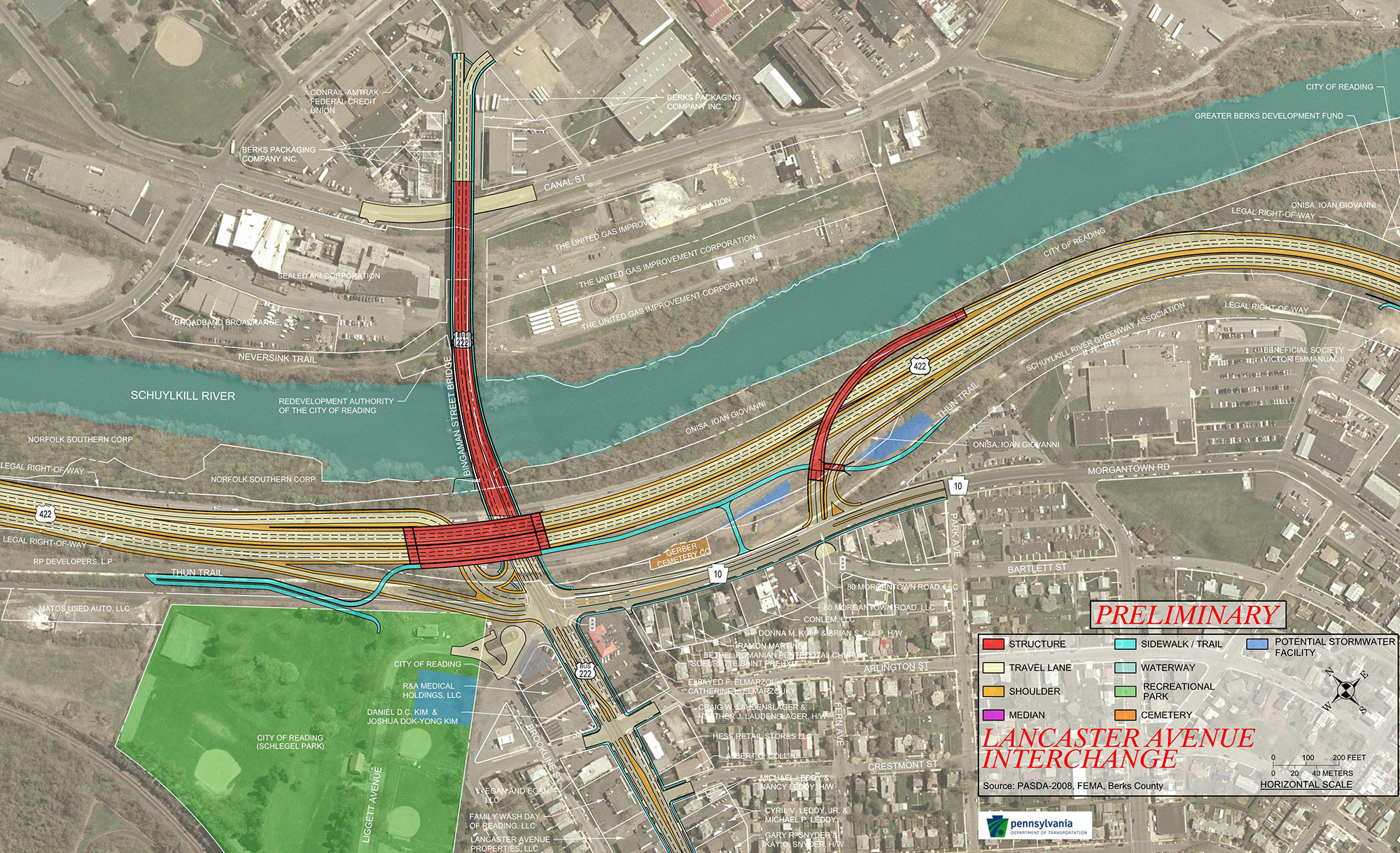Multiple highway improvement alternatives were conceptualized and presented for consideration as part of the Alternatives Analysis. Previous studies, the 2014 US Route 422 West Shore Bypass Reconstruction Study, input from PennDOT, and brainstorming sessions were used to develop design alternatives for both the Penn Street and Lancaster Avenue Interchanges. As a result of this screening process, preferred alternatives for the Penn Street and Lancaster Avenue Interchanges were developed by the project team and are presented below. Input regarding these alternatives was gathered through public presentations, stakeholder meetings, and this website. The Conceptual Point of Access study for the preferred interchange configurations was approved by PennDOT on March 8, 2018, with concurrence from FHWA on March 22, 2018.
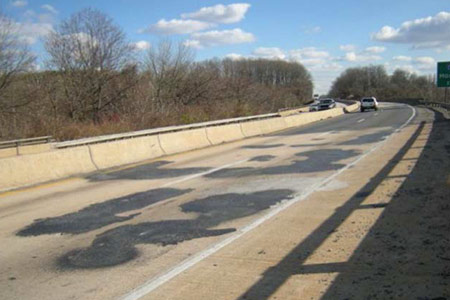
A work zone analysis was conducted to determine expected delays for lane reductions during construction. The results determined that any reduction in available lanes would result in excessive delays. Therefore, the objective is to maintain two travel lanes on US 422 in each direction during construction for both operations and incident management.
Design year traffic analyses warrant an ultimate six lane typical section from the western end of the project to the Lancaster Avenue Interchange. From Lancaster Avenue to the eastern end of the project a four lane typical section is adequate to maintain acceptable levels of service for the design life of the project, however the need to maintain two lanes of traffic in each direction during construction requires the construction of a wider overall roadway footprint, most notably at the three Schuylkill River crossing bridges. These major structures currently have twin-girder configurations, which do not accommodate phased construction. Therefore, the mainline structures from Lancaster Avenue through the eastern end of the project will be constructed to accommodate a six lane typical section in order to maintain two lanes of traffic in each direction during construction. The alignment of US 422 through this section will be adjusted to allow the bridges to be reconstructed in part width.
US 422 Mainline
The US 422 mainline will generally follow the existing alignment and the proposed typical section will consist of three 12’ lanes in each direction. The mainline will also have a typical median section of 22 feet consisting of two 10’ shoulders and a 2’ median barrier. A few areas in the corridor will require a narrower median width in order to minimize impacts to adjacent resources. One such area is under the Norfolk Southern Railroad and Buttonwood Street bridges between the N. Wyomissing Boulevard and Penn St/Penn Ave interchanges. Narrow shoulders will be required in this area in order to limit encroachment into the Schuylkill River and impacts to the overhead bridges. The existing Buttonwood Street bridge spans over US 422 will not provide the required vertical clearance for three lanes due to the arch shape of the concrete beams. The profile of US 422 through this area is also complicated by the fact that the roadway is below the 100-yr flood elevation of the Schuylkill River and had been inundated during large storm events in the past. Although the Buttonwood Street Bridge is on the National Historic Register, replacement of the spans over US 422 is being planned to provide the required vertical clearance while accommodating three 12’ lanes through each span.
The third lane on the eastbound side of US 422 will be introduced at the PA Route 12/Warren Street Bypass on-ramp and continue through to the I-176 interchange, where it will drop as an exit only lane to I-176 southbound. In the westbound direction, the third lane will be introduced as the on-ramp from I-176 northbound and continue through to the US 222 S/US 422 W exit, where it will drop as an exit only lane. Adding the third lane at I-176 and PA Route 12/Warren Street Bypass will eliminate the need to merge.
Along with the US 422 mainline, the existing N. Wyomissing Boulevard and I-176 interchanges will be reconstructed. The configuration of both interchanges will remain; however, they will be updated to accommodate the six lane mainline section and to meet current design criteria for ramp acceleration and deceleration lengths. The N. Wyomissing Boulevard interchange will also be improved to provide full movement through the interchange including a left turn from the US 422 EB off ramp.
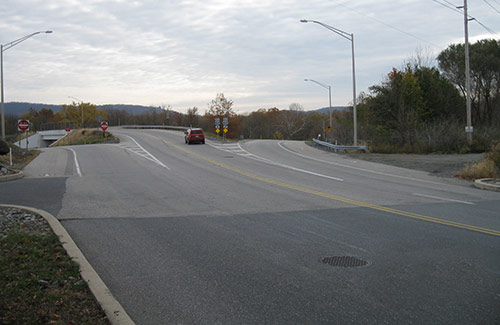
North Wyomissing Blvd Interchange looking North
N. Wyomissing Boulevard Interchange
The existing N. Wyomissing Boulevard interchange will be reconstructed in the same configuration; however, it will be updated to accommodate a six-lane mainline section and to meet current design criteria for ramp acceleration and deceleration lengths. The interchange bridge will be replaced to provide adequate horizontal clearance for the widened mainline as well as the required 16’-6” vertical clearance. The new bridge will also be widened to accommodate interstate semi-trailer turning movements from the ramps. The ramps will be lengthened to provide acceleration and deceleration lengths required under current design criteria. The mainline widening and ramp extensions to the west will require the replacement of the adjacent overhead Norfolk Southern Railroad Bridge. See proposed N. Wyomissing Boulevard Interchange.
I-176 Interchange
The I-176 interchange will retain its current configuration but be adjusted to accommodate the new mainline alignment. The ramps will be lengthened to provide acceleration and deceleration lengths required under current design criteria. The third lane on US 422 westbound will be added with the on-ramp, eliminating the need to merge. The third lane on US 422 eastbound will drop at the off-ramp to I-176 southbound. The ramp bridge over I-176 will be replaced to provide adequate horizontal clearance for the new mainline alignment as well as the required 16’-6” vertical clearance. The mainline bridges over the Schuylkill River will also be widened to accommodate the new mainline alignment and lengthened acceleration lanes. The new mainline section along with the lengthened acceleration lanes will require significant widening of the river bridges when compared to existing conditions.
The mainline alignment will be shifted in this area to accommodate construction of the two Schuylkill River bridges, which cannot facilitate part-width construction. West of I-176 the alignment will be shifted to the north, which will also eliminate impacts to the Schuylkill River Greenways Association (SRGA) trail located between I-176 and the power plant waste area in the southwest quadrant of the interchange. See proposed I-176 Interchange. To the east of I-176 the alignment will be shifted to the south.
Penn Street/Penn Avenue Interchange
The Penn Street/Penn Avenue Interchange is constrained by the Schuylkill River to the east and the Norfolk Southern Railroad to the west. The design for Penn Street/Penn Avenue will tie into the typical section of the recently completed Penn Street Bridge Rehabilitation project over the Schuylkill River. This includes four 11’ lanes, 5’ shoulders, and a 6’ median. The design to the west will tie-in before reaching the Norfolk Southern Railroad bridge over Penn Avenue, which has a vertical clearance of 13’-8”. Impacting the existing railroad bridge is a design constraint to avoid significant additional project costs associated with maintaining rail traffic during bridge replacement, as well as significant vertical geometry challenges associated with lowering Penn Avenue and/or raising the railroad.
The full cloverleaf configuration of the existing Penn Street/Penn Avenue Interchange results in weave segments on both US 422 and Penn Street/Penn Avenue which create unsatisfactory conditions for vehicles as well as bicycles and pedestrians. The current uncontrolled conflict points between vehicle and cyclists/pedestrians along Penn Street are a concern because Penn Street/Penn Avenue is a heavily traveled pedestrian route. Vehicular commuter patterns are also prevalent at Penn Street/Penn Avenue with large traffic movements from the US 422 eastbound off-ramp to Penn Street eastbound (toward downtown Reading) in the morning and from Penn Street westbound to the on-ramp to US 422 westbound (coming out of downtown Reading) in the afternoon. The intersection of 2nd Street and Penn Street, approximately 1600’ to the east of the interchange, is also an important element to this interchange as it meters traffic to the interchange. Congestion at this signal will have an effect on the operations of the Penn Street/Penn Avenue Interchange.
Design year 2046 traffic volumes were used in the capacity analysis of the Penn Street/Penn Avenue Interchange. No new traffic assignments or diversions to or from other interchanges are expected. Due to the unconventional geometric configuration evaluated at this interchange, a microsimulation analysis tool, VISSIM, was used in addition to traditional Synchro and Highway Capacity Software (HCS) analysis. This aided in evaluating how all of the different elements of the interchange design interact and affect adjacent segments, and in validating the results of the Synchro and HCS analyses.
Diverging Diamond Interchange (DDI)
At the Penn Street Interchange, a Diverging Diamond Interchange (DDI) is proposed. A DDI is a type of diamond interchange in which motorists on the non-freeway road cross to the opposite side of roadway at a signal. Then travel on the opposite side of the roadway through the interchange and at the far side of the interchange they cross back at another signal to the conventional side of travel. See proposed Penn Street/Penn Avenue interchange here / Watch Video.
The DDI allows for two-phase operation at all signalized intersections within the interchange. This design improves the efficiency of an interchange, as the lost time for various phases in the signal cycle can be reserved for the green time. The US 422 off-ramp right turns would typically be stop controlled. This DDI configuration proposes the eastbound US 422 off-ramp right turn onto Penn Avenue westbound (towards West Reading) to be stop controlled, while the westbound US 422 off-ramp right turn onto Penn Street eastbound (towards Reading) be signalized. The two right turn movements from Penn Street/Penn Avenue onto US 422 will continue to be uncontrolled movements as they are currently.
Pedestrian accommodations have been a significant point of discussion at public and stakeholder meetings. Currently, pedestrians will be accommodated by protected crossings at signalized ramps and advanced warning signs and/or systems are planned for unsignalized crossings. However, further discussions and refinements will be undertaken as the design is developed. Bicycle traffic would be accommodated in the shoulder next to the right travel lane and follow traffic through the interchange.
The proposed DDI configuration will also impact the first span of the Penn Street bridge over the Schuylkill River. The ramp from US 422 westbound to Penn Street eastbound will warrant widening in the end spans on the downstream side similar to the existing widening on the upstream side.
Lancaster Avenue Interchange
The Lancaster Avenue interchange is constrained by the Bingaman Street Bridge, Thun Trail, Gerber-Bitting Cemetery, Schlegel Park, and the Reading Fire Department Southwest Station at the PA 10/Lancaster Avenue Intersection. Furthermore, any design at Lancaster Avenue must account for the intersection of PA Route 10 with Lancaster Avenue to the immediate south of the interchange. The existing bridge carrying US 422 westbound over Lancaster Avenue has a vertical clearance of 14’-6”, below the current minimum requirement of 16’-6”. As profile changes along Lancaster Avenue would result in difficulties at the tie-ins north and south of the interchange, the profile of US 422 will be raised in this area to achieve the required clearance.
The design for Lancaster Avenue interchange will require replacement of the Bingaman Street Bridge to accommodate the new lane and ramp configurations, and because the bridge itself extends into the center of the existing interchange area. This structure currently carries four 11’ lanes with no shoulders or median, and 6’ wide sidewalks along both sides of the bridge.
Design year 2046 volumes were used in the analysis of the Lancaster Avenue interchanges for the recommended alternative. No new traffic assignments or diversions to or from other interchanges are expected. Due to the unconventional geometric configuration that was evaluated at this interchange, a microsimulation analysis tool, VISSIM, was used in addition to traditional Synchro and Highway Capacity Software (HCS) analysis. This aided in evaluating how all of the different elements of the interchange design interact and affect adjacent segments, and in validating the results of the Synchro and HCS analyses.
A modified diamond layout was investigated for the Lancaster Avenue Interchange based on the preliminary Option 4 from the 2014 US Route 422 West Shore Bypass Reconstruction Study. The modified diamond layout was further modified to provide a single intersection along Lancaster Avenue See proposed Lancaster Avenue Interchange creating an Offset Interchange with a Westbound Underpass. This alternative is closely related to the original study option but relocates the US 422 westbound off-ramp from directly intersecting Lancaster Avenue to a flyover ramp joining a new signalized access point on PA Route 10 east of Lancaster Avenue. This option will eliminate the relatively closely spaced signals on Lancaster Avenue and improve the operational efficiency of the interchange. US 422 mainline will be realigned to the center of the existing interchange area, in the location of the existing ramps. On-ramps and off-ramps will merge and diverge from the right lanes along US 422 removing the problems associated with left entrance and exit ramps.
The PA Route 10 and Lancaster Avenue intersection will be a full movement intersection with this option. Left turns will be provided for the northbound approach of PA Route 10 to accommodate traffic heading south on Lancaster Avenue. This option will also require widening of Lancaster Avenue throughout the interchange area, including across the Bingaman Street Bridge. The Thun Trail will be realigned and accommodated through the interchange area. To provide the appropriate lane configuration on the north side of the interchange, a replacement of the Bingaman Street Bridge will have to be undertaken. The elimination of the northern signalized intersection on Lancaster Avenue will also improve the constructability of the interchange as well as eliminate future issues related to closely spaced intersections like the current condition.
Historical Info
http://www.goreadingberks.com/articles/article.php?articleID=32
http://www.pahighways.com/us/US422.html





